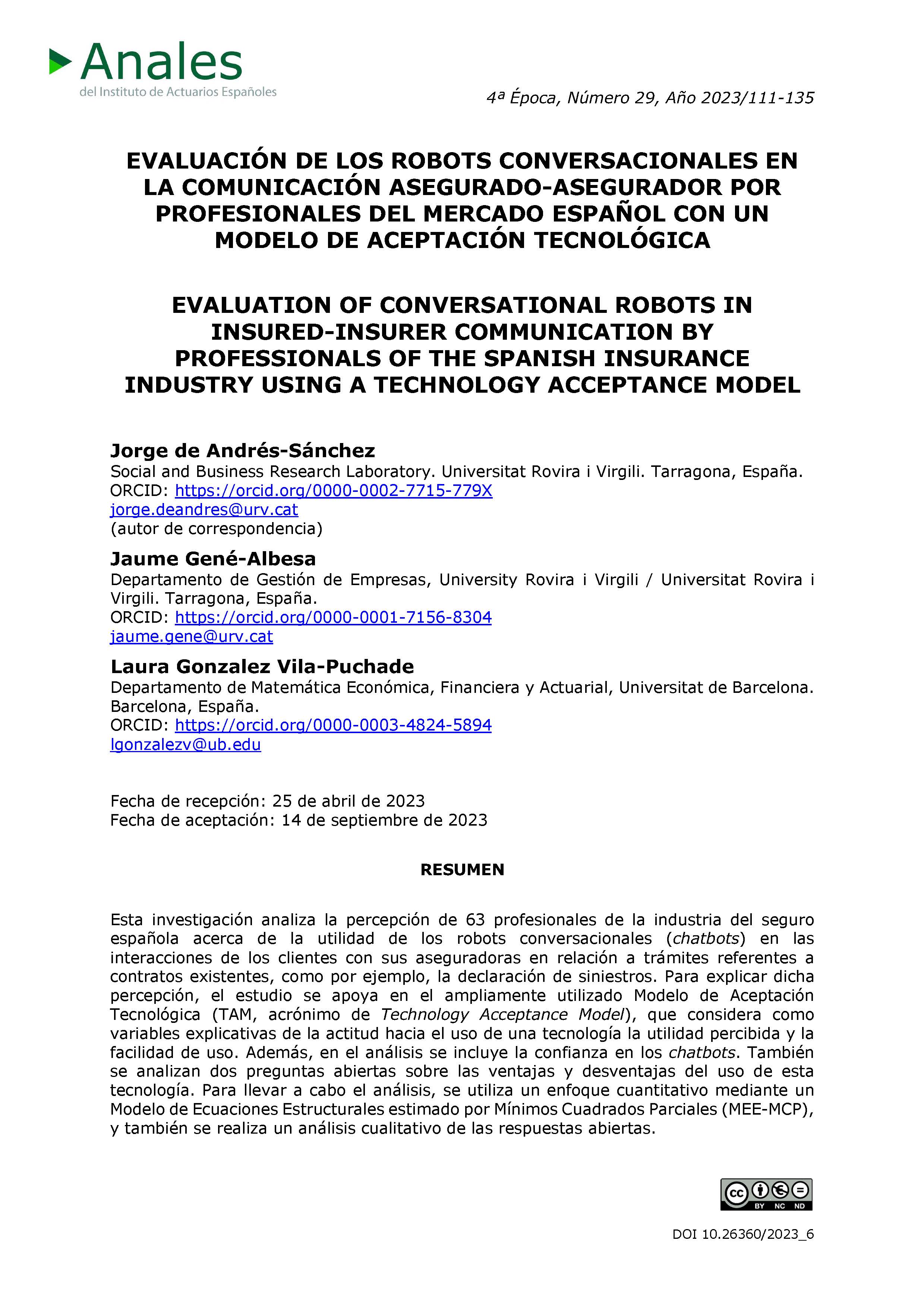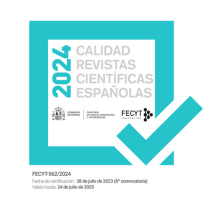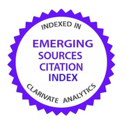Evaluation of conversational robots in insured-insurer communication in the Spanish insurance industry using a Technology Acceptance Model.
DOI:
https://doi.org/10.26360/2023_6Keywords:
Insurtech, conversational bots, Technology Acceptance Model, insurance procedures, structural equation modellingAbstract
This paper analyzes the perception of 63 professionals in the insurance industry regarding the usefulness of conversational robots (chatbots) in customer interactions with insurers regarding current policies. To explain this perception, a Technology Acceptance Model (TAM) is used that includes perceived usefulness, ease of use, and confidence in chatbots as variables. In addition, two open-ended questions are used to explore the advantages and disadvantages of using this technology. Thus, a quantitative analysis is carried out using a Structural Equation Model estimated by Partial Least Squares (PLS-SEM), and a Qualitative Analysis of the open-ended responses.
The results of the PLS-SEM analysis show a good fit of the TAM to the survey used in the research, and reveal a significant direct influence of perceived usefulness on the acceptance of conversational bots, as well as a significant impact of ease of use and confidence, but mediated by perceived usefulness. Overall, the attitude of the respondents towards conversational robots is negative. Various reasons were identified related to difficulty in interacting with them, the need to resort to the help of a human operator, the lack of emotional skills such as empathy, concern about job destruction, low reliability, and a lack of perceived advantages in terms of the impact of reducing administrative costs on product improvements.
Downloads
References
Baabdullah, A.M., Alalwan, A.A., Algharabat, R.S., Metri, B. and Rana, N.P. (2022). Virtual agents and flow experience: An empirical examination of AI-powered chatbots. Technological Forecasting and Social Change, 181, 121772. https://doi.org/10.1016/j.techfore.2022.121772
Balakrishnan, J., Abed, S. S., and Jones, P. (2022). The role of meta-UTAUT factors, perceived anthropomorphism, perceived intelligence, and social self-efficacy in chatbot-based services?. Technological Forecasting and Social Change, 180, 121692. https://doi.org/10.1016/j.techfore.2022.121692
Balasubramanian, R., Libarikian, A. and McElhaney, D. (2018). Insurance 2030 - The impact of AI on the future of insurance. McKinsey & Company. Consultado en https://www.mckinsey.com/industries/financial-services/our-insights/insurance-2030-the-impact-of-ai-on-the-future-of-insurance#/ el 12/02/2023.
Bashir, I. and Madhavaiah, C. (2015). Consumer attitude and behavioral intention toward Internet banking adoption in India. Journal of Indian Business Research, 7(1), 67-102. https://doi.org/10.1108/JIBR-02-2014-0013
Belzunegui-Eraso A. and Erro-Garcés A. (2020). Teleworking in the Context of the Covid-19 Crisis. Sustainability, 12(9), 3662. https://doi.org/10.3390/su12093662
Bhattacherjee, A. and Premkumar, G. (2004) Understanding changes in belief and attitude toward information technology usage: A theoretical model and longitudinal test. MIS Quaterly, 28(2), 229–254. https://doi.org/10.2307/25148634
Bittini, J. S., Rambaud, S. C., Pascual, J. L. and Moro-Visconti, R. (2022). Business models and sustainability plans in the FinTech, InsurTech, and PropTech industry: Evidence from Spain. Sustainability, 14(19), 12088. https://doi.org/10.3390/su141912088
Bohnert, A., Fritzsche, A. and Gregor, S. (2019). Digital agendas in the insurance industry: the importance of comprehensive approaches. The Geneva Papers on Risk and Insurance - Issues and Practice, 44, 1–19. https://doi.org/10.1057/s41288-018-0109-0
Brachten, F., Kissmer, T. and Stieglitz, S. (2021). The acceptance of chatbots in an enterprise context - A survey study. International Journal of Information Management, 60, 102375. https://doi.org/10.1016/j.ijinfomgt.2021.102375
Davis, F.D. (1989). Perceived usefulness, perceived ease of use, and user acceptance of information technology. MIS Quarterly, 13(3), 319-340. https://doi.org/10.2307/249008
DeAndrade, I.M. and Tumelero, C. (2022). Increasing customer service efficiency through artificial intelligence chatbot. Revista de Gestão, 29(3), 238-251. https://doi.org/10.1108/REGE-07-2021-0120
De Andrés-Sánchez, J., González-Vila Puchades, L. and & Arias-Oliva, M. (2021). Factors influencing policyholders' acceptance of life settlements: a technology acceptance model. The Geneva Papers on Risk and Insurance - Issues and Practice. https://doi.org/10.1057/s41288-021-00261-3
De Andrés-Sánchez, J. and González-Vila Puchades, L. (2023). Combining fsQCA and PLS-SEM to assess policyholders’ attitude towards life settlements. European Research on Management and Business Economics, 29(2), 100220. https://doi.org/10.1016/j.iedeen.2023.100220
De Andrés-Sánchez J. and Gené-Albesa, J. (2023) Assessing Attitude and Behavioral Intention toward Chatbots in an Insurance Setting: A Mixed Method Approach. International Journal of Human–Computer Interaction. https://doi.org/10.1080/10447318.2023.2227833
De Cicco, R., Iacobucci, S., Aquino, A., Romana Alparone, F. and Palumbo, R. (2022). Understanding Users’ Acceptance of Chatbots: An Extended TAM Approach. En A. Følstad, T. Araujo, S. Papadopoulos, E.L.-C. Law, E. Luger, M. Goodwin and P.B. Brandtzaeg (Eds.) Chatbot Research and Design. 5th International Workshop, CONVERSATIONS 2021, Virtual Event, November 23–24, 2021, Revised Selected Papers (pp. 3-22). Springer, Cham. https://doi.org/10.1007/978-3-030-94890-0_1
Eeuwen, M.V. (2017). Mobile conversational commerce: messenger chatbots as the next interface between businesses and consumers [Master's thesis]. University of Twente.
Farah, M.F., Hasni, M.J.S. and Abbas, A.K. (2018). Mobile-banking adoption: empirical evidence from the banking sector in Pakistan. International Journal of Bank Marketing, 36(7), 1386–1413. https://doi.org/10.1108/IJBM-10-2017-0215
Fishbein, M. and Ajzen, I. (1975). Belief, attitude, intention and behavior: an introduction to theory and research. Reading, MA: Addison-Wesley.
Fornell, C. and Larcker, D.F. (1981). Evaluating structural equation models with unobservable variables and measurement error. Journal of Marketing Research, 18(1), 39–50. https://doi.org/10.2307/3151312
Fotheringham, D. and Wiles, M.A. (2023). The effect of implementing chatbot customer service on stock returns: An event study analysis. Journal of the Academy of Marketing Science, 51, 802–822. https://doi.org/10.1007/s11747-022-00841-2
Fung, G., Polania, L. F., Choi, S. C. T., Wu, V. and Ma, L. (2021). Artificial Intelligence in Insurance and Finance. Frontiers in Applied Mathematics and Statistics, 7, 795207. https://doi.org/10.3389/fams.2021.795207
Gansser, O.A. and Reich, C.S. (2021). A new acceptance model for artificial intelligence with extensions to UTAUT2: An empirical study in three segments of application. Technology in Society, 65, 101535. https://doi.org/10.1016/j.techsoc.2021.101535
Gené-Albesa, J. (2007). Interaction channel choice in a multichannel environment, an empirical study. International Journal of Bank Marketing, 25(7), 490-506. https://doi.org/10.1108/02652320710832630
Greineder, M., Riasanow, T., Böhm, M. and Krcmar, H. (2020). The generic Insurtech ecosystem and its strategic implications for the digital transformation of the insurance industry. En: H.C. Mayr, S. Rinderle-Ma & S. Strecker (Eds.) 40 Years EMISA 2019 (pp. 119-132). Bonn. Gesellschaft für Informatik e.V.
Guiso, L. (2012). Trust and insurance markets. Economic Notes, 41(1‐2), 1-26. https://doi.org/10.1111/j.1468-0300.2012.00239.x
Guiso, L. (2021). Trust and insurance. The Geneva Papers on Risk and Insurance - Issues and Practice, 46, 509-512. https://doi.org/10.1057/s41288-021-00241-7
Hair, J.F., Risher, J.J., Sarstedt, M. and Ringle, C.M. (2019). When to use and how to report the results of PLS-SEM. European Business Review, 31(1), 2-24. https://doi.org/10.1108/EBR-11-2018-0203. 0203
Han, J. and Conti, D. (2020). The use of UTAUT and post acceptance models to investigate the attitude towards a telepresence robot in an educational setting. Robotics, 9(2), 34. https://doi.org/10.3390/robotics9020034
Hari, H., Iyer, R. and Sampat, B. (2022). Customer Brand Engagement through Chatbots on Bank Websites – Examining the Antecedents and Consequences, International Journal of Human–Computer Interaction, 38(13), 1212-1227. https://doi.org/10.1080/10447318.2021.1988487
Huang, W.S., Chang, C.T. and Sia, W.Y. (2019). An empirical study on the consumers’ willingness to insure online. Polish Journal of Management Studies, 20(1), 202-212. https://doi.org/10.17512/pjms.2019.20.1.18
Hussain, M., Mollik, A.T., Johns, R. and Rahman, M.S. (2019). M-payment adoption for bottom of pyramid segment: an empirical investigation. International Journal of Bank Marketing, 37(1), 362–381. https://doi.org/10.1108/IJBM-01-2018-0013
Jenneboer, L., Herrando, C. and Constantinides, E. (2022). The Impact of chatbots on customer loyalty: a systematic literature review. Journal of Theoretical and Applied Electronic Commerce Research, 17, 212–229. https://doi.org/10.3390/jtaer17010011
Joshi, H. (2021). Perception and Adoption of Customer Service Chatbots among Millennials: An Empirical Validation in the Indian Context. Proceedings of the 17th International Conference on Web Information Systems and Technologies - WEBIST, (pp. 197-208). https://doi.org/10.5220/0010718400003058
Kaleka, A. (2002). Resources and capabilities driving competitive advantage in export markets: guidelines for industrial exporters. Industrial Marketing Management, 31(3), 273-283. https://doi.org/10.1016/S0019-8501(00)00148-6
Kasilingam, D.L. (2020). Understanding the attitude and intention to use smartphone chatbots for shopping. Technology in Society, 62, 101280. https://doi.org/10.1016/j.techsoc.2020.101280
Kim, D.J., Ferrin, D.L. and Rao, H.R. (2008). A trust-based consumer decision-making model in electronic commerce: the role of trust, perceived risk, and their antecedents. Decision Support Systems, 44(2), 544-564. https://doi.org/10.1016/j.dss.2007.07.001
Kock, N. and Hadaya, P. (2018). Minimum sample size estimation in PLS‐SEM: The inverse square root and gamma‐exponential methods. Information Systems Journal, 28(1), 227-261. https://doi.org/10.1111/isj.12131
Koetter, F., Blohm, M., Drawehn, J., Kochanowski, M., Goetzer, J., Graziotin, D. and Wagner, S. (2019). Conversational agents for insurance companies: from theory to practice. En J. Van den Herik, A.P. Rocha & L. Steels (Eds.). Agents and Artificial Intelligence: 11th International Conference, ICAART 2019, Revised Selected Papers 11 (pp. 338-362). Prague, Czech Republic, February 19–21, 2019, Springer International Publishing. https://doi.org/10.1007/978-3-030-37494-5_17
Kovacs, O. (2018). The dark corners of industry 4.0–Grounding economic governance 2.0. Technology in Society, 55, 140-145. https://doi.org/10.1016/j.techsoc.2018.07.009
Kuberkar, S. and Singhal, T.K. (2020). Factors influencing adoption intention of AI powered chatbot for public transport services within a smart city. International Journal of Emerging Technologies, 11(3), 948-958. Available on https://www.researchtrend.net/ijet/pdf/Factors%20Influencing%20Adoption%20Intention%20of%20AI%20Powered%20Chatbot%20for%20Public%20Transport%20Services%20within%20a%20Smart%20City%20Tarun%20Kumar%20Singhal%20947.pdf
Lanfranchi, D. and Grassi, L. (2022). Examining insurance companies’ use of technology for innovation. The Geneva Papers on Risk and Insurance - Issues and Practice, 47, 520-537. https://doi.org/10.1057/s41288-021-00258-y
Lee, S., Oh, J. and Moon, W.-K. (2022) Adopting Voice Assistants in Online Shopping: Examining the Role of Social Presence, Performance Risk, and Machine Heuristic, International Journal of Human–Computer Interaction. https://doi.org/10.1080/10447318.2022.2089813
Makanyeza, C. and Mutambayashata, S. (2018). Consumers’ acceptance and use of plastic money in Harare, Zimbabwe: application of the unified theory of acceptance and use of technology 2. International Journal of Bank Marketing, 36(2), 379–392. https://doi.org/10.1108/IJBM-03-2017-0044
Martínez Ávila, M. y Fierro Moreno, E. (2018). Aplicación de la técnica PLS-SEM en la gestión del conocimiento: un enfoque técnico práctico. RIDE. Revista Iberoamericana para la Investigación y el Desarrollo Educativo, 8(16), 130-164. https://doi.org/10.23913/ride.v8i16.336
Milanović, N., Milosavljević, M., Benković, S., Starčević, D. and Spasenić, Ž. (2020). An Acceptance Approach for Novel Technologies in Car Insurance. Sustainability, 12(24), 10331. https://doi.org/10.3390/su122410331
Morgan, R.M. and Hunt, S.D. (1994). The commitment-trust theory of relationship marketing. Journal of Marketing, 58(3), 20-38. https://doi.org/10.2307/1252308
Mostafa, R.B. and Kasamani, T. (2022). Antecedents and consequences of chatbot initial trust. European Journal of Marketing, 56(6), 1748-1771. https://doi.org/10.1108/EJM-02-2020-0084
Nirala, K.K., Singh, N.K. and Purani, V.S. (2022). A survey on providing customer and public administration based services using AI: chatbot. Multimedia Tools and Applications, 81, 22215-22246. https://doi.org/10.1007/s11042-021-11458-y
Nuruzzaman, M. and Hussain, O.K. (2020). IntelliBot: A Dialog-based chatbot for the insurance industry. Knowledge-Based Systems, 196, 105810. https://doi.org/10.1016/j.knosys.2020.105810
Oktariyana, M.D., Ariyanto, D. and Ratnadi, N.M.D (2019). Implementation of UTAUT and D&M Models for Success Assessment of Cashless System. Research Journal of Finance and Accounting, 10(12), 127-137. https://doi.org/10.7176/RJFA/10-12-16
Pawlik, V.P. (2022). Design Matters! How Visual Gendered Anthropomorphic Design Cues Moderate the Determinants of the Behavioral Intention Towards Using Chatbots. En A. Følstad, T. Araujo, S. Papadopoulos, E.L.-C. Law, E. Luger, M. Goodwin & P.B. Brandtzaeg (Eds.) Chatbot Research and Design. 5th International Workshop, CONVERSATIONS 2021, Virtual Event, November 23–24, 2021, Revised Selected Papers (pp. 196-208). Springer, Cham https://doi.org/10.1007/978-3-030-94890-0_12
PromTep, S.P., Arcand, M., Rajaobelina, L. and Ricard, L. (2021). From What Is Promised to What Is Experienced with Intelligent Bots. En K. Arai (Eds.). Advances in Information and Communication: Proceedings of the 2021 Future of Information and Communication Conference (FICC), Volume 1 (pp. 560-565). Springer International Publishing. https://doi.org/10.1007/978-3-030-73100-7_40
Rajaobelina, L., PromTep, S.P., Arcand, M. and Ricard, L. (2021). Creepiness: Its antecedents and impact on loyalty when interacting with a chatbot. Psychology & Marketing, 38(12), 2339-2356. https://doi.org/10.1002/mar.21548
Riikkinen, M., Saarijärvi, H., Sarlin, P. and Lähteenmäki, I. (2018). Using artificial intelligence to create value in insurance. International Journal of Bank Marketing, 36(6), 1145-1168. https://doi.org/10.1108/IJBM-01-2017-0015
Rodríguez-Cardona, D., Werth, O., Schönborn, S. and Breitner, M.H. (2019). A mixed methods analysis of the adoption and diffusion of Chatbot Technology in the German insurance sector. AMCIS 2019 Proceedings. Twenty-fifth Americas Conference on Information Systems. Cancun. https://aisel.aisnet.org/amcis2019/adoption_diffusion_IT/adoption_diffusion_IT/18
Sá Siqueira, M.A. de, Müller, B.C.N. and Bosse, T. (2023). When Do We Accept Mistakes from Chatbots? The Impact of Human-Like Communication on User Experience in Chatbots That Make Mistakes. International Journal of Human–Computer Interaction. https://doi.org/10.1080/10447318.2023.2175158
Sánchez-Torres, J.A., Canada, F.-J.A., Sandoval, A.V. and Alzate, J.-A.S. (2018). E-banking in Colombia: factors favoring its acceptance, online trust and government support. International Journal of Bank Marketing, 36(1), 170–183. https://doi.org/10.1108/IJBM-10-2016-0145
Silva, F.A., Shojaei, A.S. and Barbosa, B. (2023). Chatbot-based services: a study on customers’ reuse intention. Journal of Theoretical and Applied Electronic Commerce Research, 18, 457–474. https://doi.org/10.3390/jtaer18010024
Sosa, I. y Montes, Ó. (2022). Understanding the InsurTech dynamics in the transformation of the insurance sector. Risk Management and Insurance Review, 25(1), 35-68. https://doi.org/10.1111/rmir.12203
Standaert, W. and Muylle, S. (2022). Framework for open insurance strategy: insights from a European study. The Geneva Papers on Risk and Insurance - Issues and Practice, 47, 643-668. https://doi.org/10.1057/s41288-022-00264-8
Stoeckli, E., Dremel, C. and Uebernickel, F. (2018). Exploring characteristics and transformational capabilities of InsurTech innovations to understand insurance value creation in a digital world. Electronic Markets, 28, 287-305. https://doi.org/10.1007/s12525-018-0304-7
Vassilakopoulou, P., Haug, A., Salvesen, L.M. and Pappas, I.O. (2023). Developing human/AI interactions for chat-based customer services: lessons learned from the Norwegian government. European Journal of Information Systems, 32(1), 10-22. https://doi.org/10.1080/0960085X.2022.2096490
Venkatesh, V. and Bala, H. (2008). Technology acceptance model 3 and a research agenda on interventions. Decision Sciences, 39(2), 273-315. https://doi.org/10.1111/j.1540-5915.2008.00192.x
Venkatesh, V. and Davis, F.D. (2000). A theoretical extension of the technology acceptance model: Four longitudinal field studies. Management Science, 46(2), 186-204. https://doi.org/10.1287/mnsc.46.2.186.11926
Venkatesh, V., Morris, M.G., Davis, G.B. and Davis, F.D (2003). User acceptance of information technology: toward a unified view. MIS Quarterly, 27(3), 425-478. http://doi.org/10.2307/30036540
Venkatesh, V., Thong, J.Y.L. and Xu, X. (2012). Consumer acceptance and use of information technology: extending the unified theory of acceptance and use of technology. MIS Quarterly, 36(1), 157-178. http://doi.org/10.2307/41410412
Vogelsang, K., Steinhüser, M. and Hoppe, U. (2013). A qualitative approach to examine technology acceptance. Thirty Fourth International Conference on Information Systems, Milan 2013. Consultado en https://core.ac.uk/download/pdf/301361231.pdf el 03/01/2023
Warsame, M.H. and Ireri, E.M. (2018). Moderation effect on mobile microfinance services in Kenya: an extended UTAUT model. Journal of Behavioral and Experimental Finance, 18, 67–75. https://doi.org/0.1016/j.jbef.2018.01.008
Warwick, K. and Shah, H. (2016) Can machines think? A report on Turing test experiments at the Royal Society. Journal of Experimental & Theoretical Artificial. Intelligence, 28(6), 989-1007, http://doi.org/10.1080/0952813X.2015.1055826
Xie, C., Wang, Y. and Cheng, Y. (2022). Does Artificial Intelligence Satisfy You? A Meta-Analysis of User Gratification and User Satisfaction with AI-Powered Chatbots. International Journal of Human–Computer Interaction. https://10.1080/10447318.2022.2121458
Xing, X., Song, M., Duan, Y. and Mou, J. (2022). Effects of different service failure types and recovery strategies on the consumer response mechanism of chatbots. Technology in Society, 70, 102049. https://doi.org/10.1016/j.techsoc.2022.102049
Yan, T.C., Schulte, P. and Chuen, D.L.K. (2018). InsurTech and FinTech: Banking and Insurance Enablement. En: Handbook of Blockchain, Digital Finance, and Inclusion, 1 (pp. 249-281). https://doi.org/10.1016/B978-0-12-810441-5.00011-7

Downloads
Published
How to Cite
Issue
Section
License
Copyright (c) 2023 Jorge de Andres Sanchez, Jaume Gene-Albesa, Laura González Vila-Puchades

This work is licensed under a Creative Commons Attribution-NonCommercial-NoDerivatives 4.0 International License.

















